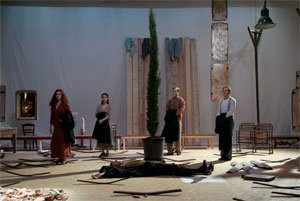Scarlatti, Il Primo Omicidio, in Lyon
 If every respectable opera house needs a Baroque performance ensemble in residence, as Hervé Niquet claimed, the Opéra national de Lyon is doing very well. Their latest production with Marc Minkowski's group, the Musiciens du Louvre—Grenoble, was a staged version of Alessandro Scarlatti's sacred divertissement Cain overo Il Primo Omicidio (February 6 to 11). I read a review by René Solis (Caïn et Abel, frères de chant, February 9) for Libération (my translation):
If every respectable opera house needs a Baroque performance ensemble in residence, as Hervé Niquet claimed, the Opéra national de Lyon is doing very well. Their latest production with Marc Minkowski's group, the Musiciens du Louvre—Grenoble, was a staged version of Alessandro Scarlatti's sacred divertissement Cain overo Il Primo Omicidio (February 6 to 11). I read a review by René Solis (Caïn et Abel, frères de chant, February 9) for Libération (my translation):
Il primo omicidio, an oratorio composed in 1707 by the prolific Alessandro Scarlatti (1659-1725), has as its plot the murder of Abel by Cain. The one that is the object of Bruno Meyssat's staging is the assassination of music by theater. This is no outrage: the second crime is just as fascinating as the first, and neither music nor theater comes out of the spectacle a loser. It was originally a collaboration between Mirella Giardelli and Bruno Meyssat. The former, a Baroque music specialist, was working with the Musiciens du Louvre, the group directed by Marc Minkowski; the latter, founder of the Théâtre du Shaman, for more than 20 years has been plowing the furrow a gestural and ritualized form of theater, haunted by the memoire of a vanished rural world.It all sounds fascinating and is a great reminder that even old music can provoke new experiments. You can see some pictures at the Lyon Opera's Image Gallery.
On the Subsistances stage, there are seven players from the Musiciens du Louvre (including Mirella Giardelli at the harpsichord), four young singers from the new studio of the Opéra de Lyon, and four actors familiar with the world of Bruno Meyssat. The musicians and singers have agreed to conform to the working methods of the director, for whom each performance is a longterm adventure, preceded by several weeks, sometimes several months, of rehearsals, with a large part of it left for improvisation. Harmony among all is not the primary goal. The performance bristles with violent interactions: parasitic sounds (barking, buzzing, falling objects), interruptions of the Italian singing with added words spoken in French, pronounced disjunctions between music and gesture.





















































No comments:
Post a Comment